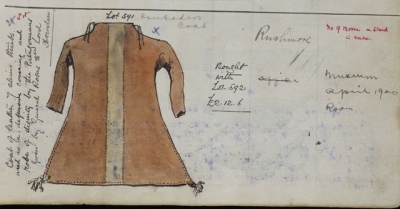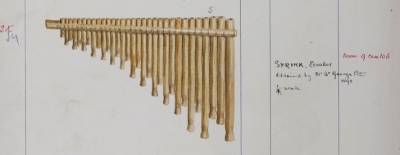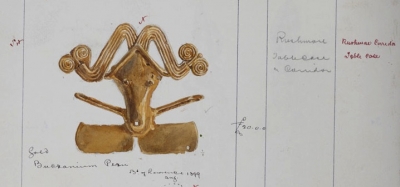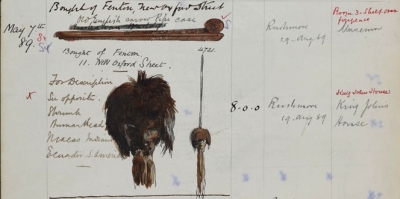To search the RPR site click here
The total number of items from South America in Pitt-Rivers’ two collections is relatively small. There are 594 in the Founding Collection and 223 in the Second Collection (this compares with, for example, Africa where the figures are 1,572 and 1,764 respectively). In the Founding Collection 318 items (53%) are classified as archaeological, 191 (32%) as ethnological and 85 (14%) as both; whereas the figures for the Second Collection are 130 (58%), 67 (30%) and 26 (12%) respectively.
The objects originate from a number of different countries as the following table shows:
|
|
Founding Collection |
Second Collection |
|
Argentina |
250 |
18 |
|
Bolivia |
1 |
6 |
|
Brazil |
23 |
6 |
|
Chile |
73 |
15 |
|
Colombia |
2 |
9 |
|
Ecuador |
48 |
6 |
|
French Guyana |
0 |
0 |
|
Guyana |
64 |
21 |
|
Paraguay |
1 |
10 |
|
Peru |
154 |
137 |
|
Surinam |
1 |
1 |
|
Uruguay |
0 |
0 |
|
Venezuela |
1 |
2 |
|
Unknown |
41 |
21 |
The totals of these columns are greater than those given above for the two collections because many items are entered on the database as coming from more than one country, so a certain amount of double counting has taken place. In fact, since many native groups are divided by international boundaries, which they may well ignore, identifying items by country of origin is in itself a slightly artificial exercise. Even so the more detailed examination of the items which follows will be conducted country by country.
Argentina
The relatively large number of items from Argentina in the Founding Collection might seem to reflect the considerable investment by Great Britain in railways, beef, etc., in that country. In fact the figure has been boosted by a single donation of 216 stone implements by William Henry Hudson, the naturalist and novelist. Hudson was born to American parents in Argentina in 1841 and moved permanently to England in 1874, the same year that he made the donation to Pitt-Rivers. Hudson found the stone tools and flakes in the Rio Negro valley, Patagonia where he was residing in 1870-1. To these may be added another four stone implements from the Rio Negro region that may or may not have formed part of Hudson’s collection.
After subtracting Hudson’s contribution, there are a further 30 items from Argentina in the Founding Collection. There are eight items, spurs, reins, whips, etc., relating to the cattle ranching industry of the pampas and Patagonia. Their previous owner had been the natural historian, the Rev. John George Wood. There are 157 items from Wood’s collection in the Founding Collection, but he was not their collector who remains unidentified. There is further ranching equipment from Patagonia; three bolas, a pair of wooden stirrups, a girth, a spur, and a further pair of wooden and leather spurs. The last was collected by J White about whom nothing has been found out. Other items are two specimens of human hair and six stone implements given by John Lubbock, later Lord Avebury and Pitt-Rivers’ son-in-law. There are three bone harpoon heads and a sling from the Yamana of Tierra del Fuego, together with a model canoe from the same region. The last was collected by Henry Nottidge Moseley in the 1870s when he was serving as a naturalist on board HMS Challenger. He was later to become the Linacre Professor of Human and Comparative Anatomy at Oxford and played a central role in the setting-up of the Pitt Rivers Museum. Finally, also from Tierra del Fuego, is a piece of fossilised horn that had been collected by Captain William Parker Snow who had commanded the South American Missionary Society’s vessel in that part of the world in the mid-1850s.
In the Second Collection there are only 18 items from Argentina and they are all classed as ethnological specimens. Six of the items are a bow and five arrows collected in the Gran Chaco by Ernest Edward Hasluck, who donated them to Pitt-Rivers. Hasluck was a clergyman in the village of Sixpenny Handley, close to Rushmore, and it seems possible that he was serving as a missionary in the Gran Chaco when he collected the objects. A further two bows with two glass-tipped arrows from Tierra del Fuego were bought from Fenton & Sons, London dealers. Also from Tierra del Fuego are four spear or harpoon heads purchased from William Webster, a dealer of Bicester, Oxfordshire. There are two maté vessels of doubtful provenance and a silver bowl, also bought from dealers. The eighteenth item is a leather coat, used as armour, from the Tehuelche of Patagonia. This item object had an interesting history. It was given by General Juan Manuel de Rosas, Governor of Argentina and pacifier of indigenous peoples, to John Caradoc, the second Baron Howden. Lord Howden was a diplomatist and soldier, who was minister in Rio de Janeiro, between 1847 and 1850, and travelled to Buenos Aires in 1847 where he met Rosas. The coat then appears to have passed into the hands of Albert Conyngham, first Baron Londesborough, an enthusiastic antiquary and collector, whose collection was sold at Christie’s in July 1888, when Pitt-Rivers acquired it. On the dispersal of the Second Collection it appears first to have been bought by James Economos, but it has finally ended up in the Smithsonian Institute in Washington.
Bolivia
None of the items in either collection can be securely identified as coming from Bolivia. The single item in the Founding Collection, which may equally well have come from Peru, is an artificially elongated skull. This type of deformation is associated with the Tiahuanaco culture and it came from the Titicaca region, on the frontier between the two countries. The only items in the Second Collection are the bow and arrows donated by the Reverend Hasluck and already referred to as possibly coming from Argentina.
Brazil
Of the 23 items from Brazil in the Founding Collection nine of them were donated by Richard Francis Burton, the explorer, who was British consul in Santos, Brazil for five years from 1864. Five of the items are stone tools from the region of Santos, and the other four from the Botocudo Indians; three of them objects carved from horn and one a shirt. The objects made from horn cannot be from the traditional pre-conquest culture, since no horned animals are native to South America. Another stone tool from the Madeira River region had been owned by H G Williams, about whom nothing has been found out. The other items consist of assorted Amerindian objects: two spears, two bows, a necklace, a comb, a calabash vessel and a flute made from a jaguar’s tibia. None of the collectors or previous owners of these objects is recorded, except for the flute which had passed through the hands of the Parisian dealer, Eugène Boban. There is a model of a Brazilian jangada raft, used by fishermen in the State of Ceará. A portrait of a Maopityan Indian by Edward Goodall, official artist on Robert Schomburgk’s boundary survey of British Guiana in the 1840s, had been owned by a Dr King of Blandford Street, London, about whom nothing further has been discovered. The two remaining items are a piece of tree bark used for making cord, and a whip for beating clothes in the course of washing them. The former is said to be made from embira cheviosa, but in fact embira is a Brazilian word, derived from the Tupí, for cord made from plants of the Family Annonaceae. The latter is another item from the collection of the Rev. John George Wood.
The six items from Brazil in the Second Collection were all bought from the dealer William Downing Webster in May 1898. Four of them are pottery objects, three vessels and one figure, all from the Rio Negro. The figure and one of the vessels may be Amerindian; the other two are almost certainly Brazilian. There is a metal funnel or filter from the same region and an Amerindian club just designated as from Brazil.
Chile
Of the 73 items from Chile contained in the Founding Collection, no fewer than 63 of them have already been referred to as they are also classified as coming from Argentina. There are two Araucanian lassos made from cowhide, one from John Wood’s collection, and a pack of playing cards of the same material. Other leather items are two decorated leather belts. Two decorated double-sided combs make up the ethnological items. Classified as archaeological are two Chimu pottery vessels and a piece of textile; the last probably coming from Wood’s collection.
It is a similar story with Chilean objects from the Second Collection; out of the 27, 11 have already been dealt with under Argentina. A further 12 are from Rapa Nui (Easter Island) and are thus strictly speaking Polynesian objects. This just leaves four items which are classified as definitely from Chile. Two of them are human vertebra, both with an arrowhead embedded in them. The others, both pottery objects are a bowl and a sherd from the Atacama Desert.
Colombia
The only items from Colombia in the Founding Collection are two stone axes. These reached Pitt-Rivers through the hands of Robert McKenzie Cross, a botanist who was the field collector, and Clements Robert Markham, a geographer. Both Markham and Cross were important figures in the transfer of chinchona (quinine) and rubber seeds from South America to India. The Second Collection contained nine items, one of which, a pottery figure, about which there is virtually no information may have been of Mexican origin, and two, pottery vessels, may have come from Venezuela. The latter were bought from the dealer Bryce McMurdo Wright junior on 23 March 1888 for 10/- (about £30 today). The other six are all ornaments or grave goods, one of amber and the rest of gold. Pitt-Rivers bought these from the London dealer William Talbot Ready on 25 November 1893.
Ecuador
With 48 items Ecuador is well represented in the Founding Collection compared with most other South American countries. Nearly half of these, 20 objects, come from the Achuar Indians of Amazonian Ecuador, and in turn at least half of these were collected by Clarence Buckley, a natural historian, and more may have been. Half of all the Achuar objects are ornaments of some kind, and there are three flutes and two spears. The remaining five objects include two specimens of human hair, one specimen of animal hair, and two shrunken heads, one a sloth’s and the other human.
Of the remaining 28 items a further six were collected by Buckley. These include three stone tools or weapons, one metal tool and two pottery vessels. The rest compose a rather mixed bunch ranging from a painting of a Christian saint to various stone and pottery objects. Some of these were bought from the dealer Bryce McMurdo Wright, but for many objects information is lacking.
The Second Collection contained just six items. There is another Achuar shrunken head, which Pitt-Rivers bought in 1889 from the London dealers Fenton & Sons, for £8 (about £480 today). There are two paddles, almost certainly Amerindian, from another dealer, William Downing Webster. The other three items are two pottery vessels and a set of panpipes donated by the General’s second son, St George William Lane Fox-Pitt.
Guyana
The Founding Collection contains 64 items from what was British Guiana. With one or two exceptions, all the objects are of Amerindian origin, although rarely do we know from which of the various groups they came. Six of the objects are credited as coming from the Macusi, three from the Caribs, one each from the Akawaio and Warao, and the remainder are uncredited. We are equally in the dark about the collectors. A Carib musical instrument was collected by a Mr Elliot who may be the Richard Elliot who was a missionary in Demerara in the early Nineteenth century. There are four watercolour portraits of Amerindians painted by Edward Goodall, who accompanied Robert Schomburgk’s boundary survey in 1841-43. They all reached Pitt-Rivers via a Dr King of Blandford Street, London. The other previous owners recorded are the dealer Bryce McMurdo Wright, John George Wood, and John Lubbock, Lord Avebury, who had owned two of the five stone tools contained in the collection. Among the other objects there are 17 basketry items, 14 of which are baskets, together with two model cassava squeezers, the framework of a feather headdress, and a basketwork quiver for blowgun darts. There are two blowguns, ten clubs, three bows, two model canoes, and two paddles. There are eight assorted ornaments, including the headdress just mentioned and an Akawaio ritual whip. There are two woman’s aprons, a Macusi bead one and a Warao bark one.
The Second Collection contains 21 items from Guyana. They are all of Amerindian origin but there is no information on which specific group any of the objects came from, nor do we know who any of the field collectors or previous owners were. The majority, 15 items, were acquired from the Colonial and Indian Exhibition of 1886, and it is possible that this collection was put together for the Exhibition by Everard Im Thurn, who gave numerous objects to the Pitt Rivers Museum in the 1890s. It consists of various items of everyday use from a variety of basketwork, including a sieve and a cassava squeezer, a sling for carrying a baby, stools, cotton spindle, a bead apron to a bone flute. The other six items are an assortment, all obtained from dealers or auction houses. There are two necklaces of plant seeds and glass beads bought at Sotheby’s, three clubs, two from Fenton & Sons and one from William Downing Webster, the latter dealer also supplying a flute, reputedly made from a human bone, and a canoe paddle.
Paraguay
There is only one object, a textile belt, in the Founding Collection that is recorded as coming from Paraguay but there is considerable doubt about this and Tahiti is listed as an alternative. The situation is only marginally better with regard to the Second Collection. Of the ten items, six, consisting of a bow and five arrows, came from the Gran Chaco region and may equally well have been of Argentinean or Bolivian origin. The other four items are the four sides of the carved wood stem of a smoking pipe.
Peru
Next to Argentina, Peru, with 154 items, was the country that was the source of the largest number of South American objects in the Founding Collection. The majority of items, 93, are classified as archaeological, with 24 as ethnological, and uncertainty surrounding 37 which are classified as both. Pottery, predominantly archaeological objects from cotton spindle whorls to figures, forms one-third of the total collection. Both Amerindian and Euro-Peruvian items form part of the collection with greater emphasis on the former. One might be expect, given that both Amerindian and archaeological objects dominate, that the areas best represented would be the Highlands and Pacific coast, but in fact we cannot be certain as for 124 out of the 154 items the specific region of origin is unknown. Out of the remaining 30, 14 came from Arica on the coast and six from the Ucayali valley in the Peruvian Amazon. Five of the latter are identified as being from the Shipibo-Conibo people and it is possible that the sixth is also.
On turning to the Second Collection, we find that it contained 137 items. The preponderance of archaeological objects is even more pronounced with 117 classified thus, 15 as either archaeological or ethnological and only five as just ethnological. Once again, with 108 items, pottery objects predominate. There are five items which are human skeletal remains, and the remaining objects are of stone, wood, and metal, including a gold animal figure that cost £20 (£1,141). There is no record of what region 136 of the items originate. Interestingly 107 of the objects were bought from two dealers, William Downing Webster and George Fabian Lawrence, in 1898 and 1899, at the very end of Pitt-Rivers’ life.
Surinam
Both the Founding Collection and the Second Collection contain but a single item from Surinam. In the case of the former it is an iron-headed harpoon and of the latter a cotton sling for carrying an infant, although it more probably came from Guyana next door.
Venezuela
There are also very few items from Venezuela. The Founding Collection contains a gold nose-ring and the Second Collection three pottery vessels, which may equally well have come from Colombia, acquired from the dealer Bryce McMurdo Wright junior in 1888 for 10/- (£30).
French Guiana and Uruguay
There are no objects from these countries in either of the collections.
Unknown
There are 41 items in the Founding Collection listed as coming from South America but for which the country of origin is unrecorded. Only one of the items is classified as archaeological, although, as it is a flask made from a cow’s horn, it cannot be earlier than the 16th century. There are 28 ethnological items and 12 classified as both. Nine of the latter are stone implements and the other three metal spurs which must also be post-conquest. In fact there are a number of other spurs, stirrups, etc., which are classified as just ethnological. Most of the ethnological items are of Amerindian origin, and include bows, arrows, blow guns, club, spear-thrower, and ornaments.
In the Second Collection there are 21 items from South America for which the country of origin in unknown. The majority, 12 items, are classified as ethnological, including five mate drinkers, and a variety of other objects. The five archaeological items three pottery vessels and a clay spindle whorl. All save one of the objects were acquired from dealers with whom Pitt-Rivers regularly did business; Cutter, Fenton, Lawrence, Webster, and Wright,
Summary
It cannot be said that the South American items in either of the two collections include any particularly outstanding pieces, with the possible exception of the leather coat that had been in the possession of General de Rosas. Most of the objects are of a fairly mundane nature and consist of disparate articles rather than forming coherent assemblies.
Peter Rivière, July 2011







